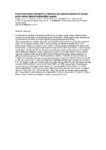Por favor, use este identificador para citar o enlazar este ítem:
http://www.alice.cnptia.embrapa.br/alice/handle/doc/853911Registro completo de metadatos
| Campo DC | Valor | Lengua/Idioma |
|---|---|---|
| dc.contributor.author | OLIVEIRA, M. E. F. | pt_BR |
| dc.contributor.author | NASCIMENTO, P. M. P. | pt_BR |
| dc.contributor.author | TERIXEIRA, P. P. M. | pt_BR |
| dc.contributor.author | PIERONI, J. S. P. | pt_BR |
| dc.contributor.author | LIMA, M. R. | pt_BR |
| dc.contributor.author | BICUDO, S. D. | pt_BR |
| dc.contributor.author | FONSECA, J. F. da | pt_BR |
| dc.contributor.author | VICENTE, W. R. R. | pt_BR |
| dc.date.accessioned | 2012-06-23T01:02:05Z | - |
| dc.date.available | 2012-06-23T01:02:05Z | - |
| dc.date.created | 2010-05-26 | pt_BR |
| dc.date.issued | 2010 | pt_BR |
| dc.identifier.citation | Reproduction, Fertility and Development, v. 22, n. 1, p. 174, 2010. | pt_BR |
| dc.identifier.uri | http://www.alice.cnptia.embrapa.br/alice/handle/doc/853911 | pt_BR |
| dc.description | Low levels of progesterone (P4) during synchronization of estrus in ewes can promote excessive growth of the follicles, resulting in large persistent and old ovulatory follicles. Timing of ovulation or the LH surge in relation to onset of estrus is also more variable with lower P4. These findings have been related to reduction in fertility in ewes (Viñoles et al. 2001 Theriogenology 55, 993-1004). To avoid prolonged periods of subluteal P4 concentrations, the aim of this study was to compare long protocols with or without CIDR replacement in Santa Inês sheep during the breeding season. Twenty-three adult ewes were divided into 2 groups (G-1CIDR, n = 11 and G-2CIDR, n = 12). Estrus was synchronized with a P4 device (CIDR?; Pfizer-New Zealand, Auckland, New Zealand) for 14 d. However, in G-2CIDR, the CIDR was replaced by a new one on Day 7. Doses of 2.5 mg of dinoprost, i.m. (Lutalyse?, Pfizer-New Zealand) were administered on Days 0 and 14. All ewes received 300 IU of eCG (Novormon?, Syntex, Buenos Aires, Argentina) on Day 14. Estrus detection was accomplished using a teaser ram starting 12 h after CIDR removal and was repeated 3 times a day for 4 d. Ultrasonographic exam was used every 8 h for 5 d after the end of the treatment to determine the moment of ovulation and the diameter of the ovulatory follicle. Data were analyzed by ANOVA using SAS software (chi-square and Tukey tests). The proportions of treated ewes that were detected in estrus did not differ statistically between groups (G-1CIDR: 90.9% and G-2CIDR: 100%). The interval from onset estrus to CIDR removal differed (P < 0.05), between G-1CIDR (37.80 ± 8.02 h) and G-2CIDR (49.00 ± 9.16 h) groups. The frequency distributions of estrus in G-1CIDR ewes were 10, 70, 10, and 10% at 24, 36, 48, and 54 h, respectively, compared with 8.33, 8.33, 50, 8.33, and 25% at 30, 36, 48, 54, and 60 h after CIDR removal in the G-2CIDR ewes. All ewes ovulated at the end of the synchronization protocols. Ovulation occurred at 69.45 ± 10.00 h and 76.66 ± 15.04 h after the end of the protocols in G-1CIDR and G-2CIDR, respectively (P > 0.05). The ovulation frequency distribution for ovulation time in G-1CIDR was 27.27, 54.54, 9.09, and 9.09% at 60, 68, 84, and 92 h, whereas in G-2CIDR, 8.33, 50, 16.66, 8.33, 8.33, and 8.33% ovulated at 60, 68, 76, 92, 100, and 108 h after the end of treatment. The interval between estrus and ovulation was 29.40 ± 9.97 h in G-1CIDR compared with 27.66 ± 11.71 h in G-2CIDR (P > 0.05). The number of ovulations per animal and diameters of ovulatory follicles were 1.54 ± 0.82 and 6.95 ± 0.75 mm in G-1CIDR and 1.33 ± 0.77 and 7.00 ± 1.22 mm in G-2CIDR, respectively (P > 0.05). These results showed a later onset of estrus in G-2CIDR. However, the treatment with CIDR replacement did not promote an effect on ovulation rate and number of ovulatory follicles. Both protocols showed efficiency. | pt_BR |
| dc.language.iso | eng | eng |
| dc.rights | openAccess | eng |
| dc.subject | CIDR | pt_BR |
| dc.subject | Raça Santa Inês | pt_BR |
| dc.subject | Brasil | pt_BR |
| dc.subject | Minas Gerais | pt_BR |
| dc.subject | Protocolo | pt_BR |
| dc.title | Timing of ovulation and estrus in long protocols with or without CIDR replacement in santa inês sheep during breeding season. | pt_BR |
| dc.type | Resumo em anais e proceedings | pt_BR |
| dc.date.updated | 2019-09-23T11:11:11Z | pt_BR |
| dc.subject.thesagro | Ovino | pt_BR |
| dc.subject.thesagro | Reprodução animal | pt_BR |
| dc.subject.thesagro | Inseminação artificial | pt_BR |
| dc.subject.thesagro | Progesterona | pt_BR |
| dc.subject.thesagro | Fertilidade | pt_BR |
| dc.subject.thesagro | Redução | pt_BR |
| dc.subject.thesagro | Ovulação | pt_BR |
| dc.subject.nalthesaurus | Sheep | pt_BR |
| dc.subject.nalthesaurus | Controlled internal drug release devices | pt_BR |
| dc.subject.nalthesaurus | Animal reproduction | pt_BR |
| dc.subject.nalthesaurus | Progesterone | pt_BR |
| dc.description.notes | Edição dos Proceedings of the Annual Conference of the International Embryo Transfer Society, Córdoba, Argentina, 9-12 January 2010. | pt_BR |
| riaa.ainfo.id | 853911 | pt_BR |
| riaa.ainfo.lastupdate | 2019-09-23 -03:00:00 | pt_BR |
| dc.identifier.doi | 10.1071/RDv22n1Ab33 | pt_BR |
| dc.contributor.institution | Universidade Estadual Paulista, Jaboticabal, SP.; UNESP; UNESP; UNESP; UNESP; JEFERSON FERREIRA DA FONSECA, CNPC; UNESP. | pt_BR |
| Aparece en las colecciones: | Resumo em anais de congresso (CNPC)  | |
Ficheros en este ítem:
| Fichero | Descripción | Tamaño | Formato | |
|---|---|---|---|---|
| RACTimedhormonaltreatmentsininductionandsynchronizationofSaanen.pdf | 145,36 kB | Adobe PDF |  Visualizar/Abrir |









